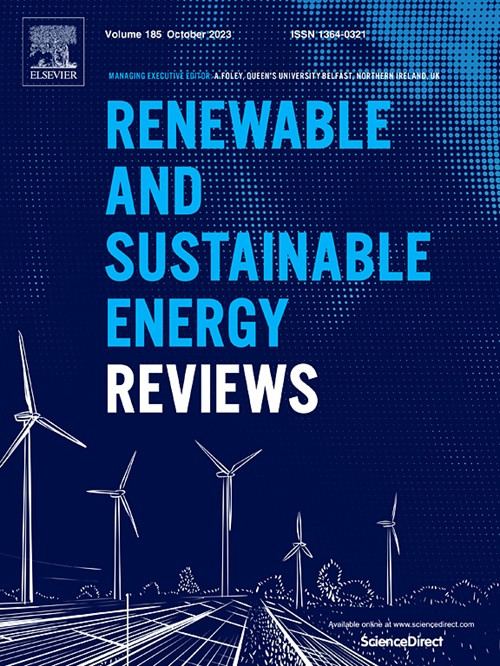真实波浪气候条件下波浪能转换阵列布局优化
IF 16.3
1区 工程技术
Q1 ENERGY & FUELS
引用次数: 0
摘要
波能变换器阵列的产生效率主要取决于阵列布局。因此,优化阵列布局使WEC阵列的能量产量最大化是波能领域的一个重要研究课题。现有工作在模型精度、布局策略、波浪气候等方面的局限性制约了优化结果的适用性。本文首次考虑实际WEC系统和一般波浪气候,深入探讨了波浪气候、波浪相互作用和阵列布局之间的内在关系。目的是为WEC阵列的设计提供更通用的指导。首先,利用边界元法建立了二体WEC阵列的高保真时域数值模型,以准确评估阵列中器件之间的相互作用。随后,提出了一种新的布局策略,以提高阵列布局的优化效率。在验证了数值模型和布局策略后,对不同波气候下由4、8和12个器件组成的阵列进行了全面的布局优化。本文着重分析了所得到的优化布局的年平均输出功率和波浪相互作用。所考虑的波浪气候包括来自三个潜在部署地点的单向平均气候和多向现实气候。结果表明,单向气候假设显著高估了阵列的建设性相互作用,在此假设下得到的最优布局不适用于多向气候。本文章由计算机程序翻译,如有差异,请以英文原文为准。
Layout optimization of wave energy converter arrays in realistic wave climates
The production efficiency of a wave energy converter (WEC) array depends mainly on the array layout. Therefore, optimizing the array layout to maximize the energy production of WEC arrays is an important research topic in the field of wave energy. The limitations of existing works in terms of model accuracy, layout strategy, and wave climate constrain the applicability of optimization results. This paper thoroughly investigates the inherent relationships between wave climate, wave interactions, and array layout, considering practical WEC systems and general wave climates for the first time. The aim is to provide more universal guidance for the design of WEC arrays. First, a high-fidelity time-domain numerical model of a two-body WEC array is constructed using the boundary element method to accurately assess the interactions between devices in the array. Subsequently, a novel layout strategy is presented to enhance the optimization efficiency of the array layout. After validating the numerical model and layout strategy, a thorough layout optimization of arrays consisting of 4, 8, and 12 devices in diverse wave climates is performed. The paper specifically focuses on analyzing the annual mean power output and wave interactions of the obtained optimal layouts. The wave climates considered involve both unidirectional mean and multidirectional realistic climates from three potential deployment sites. The results show that the unidirectional climate assumption significantly overestimates the constructive interactions of arrays, and the optimal layouts obtained under this assumption is not applicable to multi-directional climates.
求助全文
通过发布文献求助,成功后即可免费获取论文全文。
去求助
来源期刊

Renewable and Sustainable Energy Reviews
工程技术-能源与燃料
CiteScore
31.20
自引率
5.70%
发文量
1055
审稿时长
62 days
期刊介绍:
The mission of Renewable and Sustainable Energy Reviews is to disseminate the most compelling and pertinent critical insights in renewable and sustainable energy, fostering collaboration among the research community, private sector, and policy and decision makers. The journal aims to exchange challenges, solutions, innovative concepts, and technologies, contributing to sustainable development, the transition to a low-carbon future, and the attainment of emissions targets outlined by the United Nations Framework Convention on Climate Change.
Renewable and Sustainable Energy Reviews publishes a diverse range of content, including review papers, original research, case studies, and analyses of new technologies, all featuring a substantial review component such as critique, comparison, or analysis. Introducing a distinctive paper type, Expert Insights, the journal presents commissioned mini-reviews authored by field leaders, addressing topics of significant interest. Case studies undergo consideration only if they showcase the work's applicability to other regions or contribute valuable insights to the broader field of renewable and sustainable energy. Notably, a bibliographic or literature review lacking critical analysis is deemed unsuitable for publication.
 求助内容:
求助内容: 应助结果提醒方式:
应助结果提醒方式:


